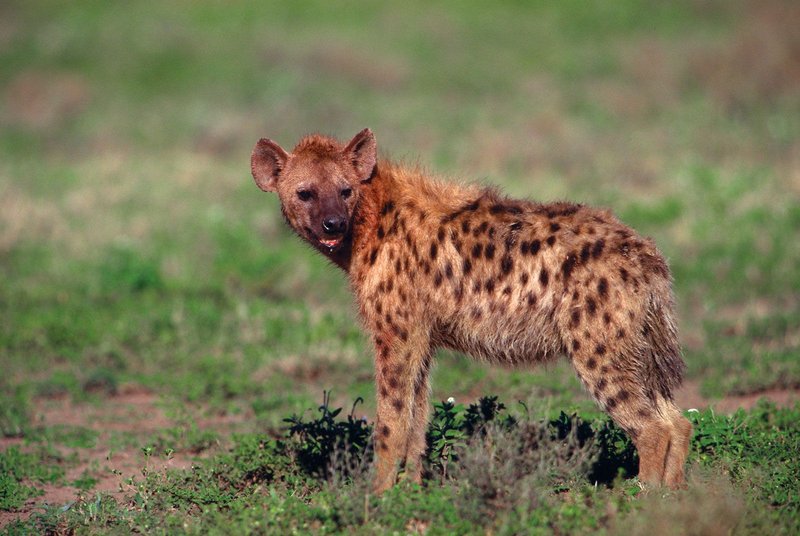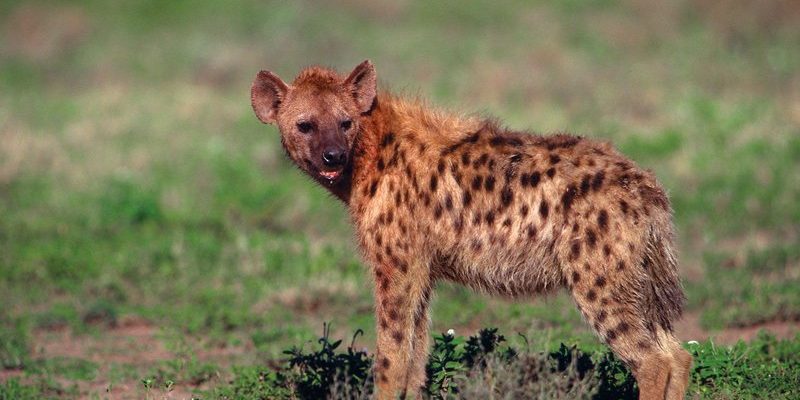
When you hear the word “hyena,” what comes to mind? Maybe it’s the distinctive laugh that seems to echo through the African savanna. Or perhaps you think of their unique, ferocious appearance. Hyenas are often misunderstood creatures, frequently labeled as scavengers. But there’s a lot more to these intriguing animals than meets the eye. They have complex social structures, fascinating behaviors, and a crucial role in their ecosystems.
Hyenas belong to the family Hyaenidae, which includes four species: the spotted hyena, brown hyena, striped hyena, and the aardwolf. Each species has its own unique traits, but they all share some common features that make them stand out. From their powerful jaws to their social hierarchy, hyenas are remarkable animals that deserve some attention beyond their bad reputation.
Physical Characteristics of Hyenas
Hyenas are known for their sturdy build and unique features. The largest and most recognized species is the spotted hyena, which can weigh up to 190 pounds and measure about 4.5 to 5.5 feet long. They have a distinctive appearance with a sloping back, large ears, and a short tail. Their fur is coarse and typically brown with black spots, which help them blend into the dry grasslands of their habitat.
One of the most notable aspects of hyenas is their jaw strength. Their powerful jaws can crush bones, allowing them to access the nutrient-rich marrow inside. This ability gives hyenas an edge when it comes to scavenging. It’s like having a built-in tool for accessing food that most other animals can’t reach. Their teeth, specifically designed for this, are perfectly adapted for their scavenging lifestyle.
Unique Adaptations
Hyenas aren’t just tough on the outside; they also have some impressive adaptations that help them thrive in their environments. For instance, they’re incredible runners, able to reach speeds of up to 40 miles per hour. This speed allows them to chase down prey or escape from larger predators. Hyenas also have excellent stamina, which means they can keep running longer than most animals.
In addition to their physical adaptations, hyenas have highly developed social behaviors. They live in groups called clans, which can consist of up to 80 individuals. These clans have a complex social hierarchy, often led by a dominant female. Imagine a bustling community where everyone works together, and you’ll get a sense of hyena social life. This hierarchy plays a crucial role in their survival, as it ensures that the strongest and most capable members of the clan are able to lead and protect the group.
Habitat and Distribution
Hyenas are primarily found in Africa, with the spotted hyena being the most widespread. They thrive in a variety of habitats, including savannas, grasslands, and even mountainous regions. You might be surprised to learn that some hyenas can also be found in parts of the Middle East and India, where the striped hyena roams. These adaptable creatures can survive in diverse environments, which is one reason why they are resilient and successful.
In their habitats, hyenas play a crucial role in maintaining ecological balance. By scavenging and hunting, they help control populations of other animals, thus preventing overgrazing and promoting healthy ecosystems. Imagine them as nature’s cleanup crew, ensuring that resources are used efficiently and that the environment remains vibrant and diverse.
Diet and Hunting Behavior
Hyenas are often stereotyped as scavengers, but in reality, they are skilled hunters. While they do eat carrion, they are also proficient at hunting live prey. In fact, spotted hyenas hunt successfully about 50% of the time. This makes them more than just opportunistic feeders; they have a strategic approach to finding food.
Their diet mainly consists of small to medium-sized mammals, such as wildebeest, antelope, and even smaller carnivores. They have been known to work together in groups to take down larger prey, showcasing their cooperation and intelligence. Think of them as a team of well-coordinated athletes, strategizing and executing their moves to secure their meals.
Social Structure and Behavior
Hyenas have one of the most complex social structures in the animal kingdom. As mentioned earlier, they live in clans that are matriarchal, meaning females hold the primary power. This is quite unusual in the animal world, where males are often dominant. Female hyenas have higher social status, which affects their breeding opportunities and access to food.
Within these clans, relationships are established through social grooming, vocalizations, and even play. They communicate with each other using a range of sounds, including their characteristic laughs and whoops. This vocal communication helps to maintain social bonds and coordinate group activities. Picture a lively family gathering where everyone is chatting, laughing, and playing together — that’s how hyenas socialize!
Reproduction and Lifespan
Breeding among hyenas is fascinating. Female spotted hyenas give birth to one to four cubs after a gestation period of about 110 days. Interestingly, the cubs are born with their eyes open and have a dark coat that changes to the more familiar spotted pattern as they grow. This is a significant advantage, as they’re able to start interacting with their clan right away, which is essential for their survival.
The lifespans of hyenas vary by species, but they generally live around 10 to 12 years in the wild. However, those in captivity can live much longer, sometimes exceeding 20 years. Their life expectancy often depends on environmental factors, food availability, and predation pressures. Like many wild animals, hyenas face challenges that can impact their survival and wellbeing.
Conservation Status
Despite their resilience, hyenas face threats from habitat loss, human-wildlife conflict, and hunting. The major challenge arises from increasing human populations encroaching on their habitats, which leads to conflicts over land and resources. In some areas, hyenas are seen as pests, leading to negative perceptions and persecution.
Fortunately, conservation efforts are underway to help protect hyena populations. Organizations are working to educate local communities about the importance of hyenas in their ecosystems and to promote coexistence strategies. Protecting their habitats and reducing human conflict will be key in ensuring that these fascinating animals continue to thrive.
Interesting Facts About Hyenas
| Species | Spotted, Brown, Striped, Aardwolf |
| Weight | Up to 190 pounds (Spotted Hyena) |
| Length | 4.5 to 5.5 feet |
| Speed | Up to 40 miles per hour |
| Lifespan | 10 to 12 years in the wild; up to 20 years in captivity |
| Social Structure | Matriarchal clans |
| Diet | Scavengers and hunters of small to medium-sized mammals |
Myth vs. Reality
Many myths surround hyenas, painting them as ruthless, cowardly scavengers. However, the reality is far more nuanced. While they do scavenge, they are also skilled hunters. Their social structure is incredibly intricate, showcasing cooperation and intelligence. By breaking down these myths, we can appreciate hyenas for the complex beings they are.
Moreover, their “laughter” doesn’t signify something sinister; rather, it’s a form of communication. This laugh can express excitement or stress, making it a vital part of their interactions. So, the next time you hear that distinctive sound, remember it’s a conversation among family members!
FAQ
Are hyenas dangerous to humans?
Hyenas are generally not a threat to humans, but they can become dangerous if they feel threatened or cornered. They are more likely to avoid human contact. However, in some areas where their habitats overlap with human settlements, conflicts can arise, especially if they are scavenging in garbage or farms.
How do hyenas communicate?
Hyenas have a complex communication system that includes vocalizations, body language, and social grooming. Their famous laugh is just one of the many sounds they make, which helps them convey different emotions and intentions within their clan.
What is the difference between a hyena and a dog?
Hyenas and dogs are part of different families in the animal kingdom. While they share some similarities, such as pack behavior and certain physical traits, hyenas are more closely related to cats than dogs. Their anatomy, social structure, and hunting techniques are distinct from those of dogs.
Can hyenas run as fast as a cheetah?
While hyenas can reach speeds of up to 40 miles per hour, they cannot run as fast as a cheetah, which can sprint up to 60 miles per hour. However, hyenas excel in endurance, making them capable of chasing prey for longer distances.
How long do hyena cubs stay with their mothers?
Hyena cubs typically stay with their mothers for about a year, relying on her for nourishment and protection. During this time, they learn essential survival skills and social behaviors that will help them thrive as they grow older.
Are hyenas solitary animals?
No, hyenas are social animals that live in clans. These clans can consist of up to 80 individuals, working together for hunting and protection. Their social structure is complex and matriarchal, which means females hold the highest status within the group.
What do hyenas eat?
Hyenas are opportunistic feeders, which means they eat a variety of food sources. Their diet consists mainly of small to medium-sized mammals, but they also scavenge when necessary. They have the unique ability to digest bones, which makes them incredibly effective in their ecological roles.
How can we help hyenas?
You can help hyenas by supporting conservation efforts and spreading awareness about their ecological importance. Engaging with organizations that work on protecting their habitats and educating communities can significantly impact their survival.
What are the main threats to hyenas?
The main threats to hyenas include habitat loss due to human expansion, hunting, and negative perceptions that lead to persecution. By understanding these threats, we can focus on developing strategies to mitigate human-wildlife conflict and promote the coexistence of hyenas and people.
Do hyenas have any predators?
Adult hyenas have few natural predators due to their size and strength. However, young cubs can fall prey to lions and other large carnivores. The social structure of hyenas helps protect the young from potential threats within their environment.

